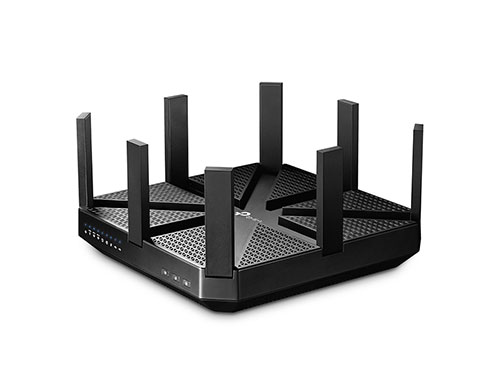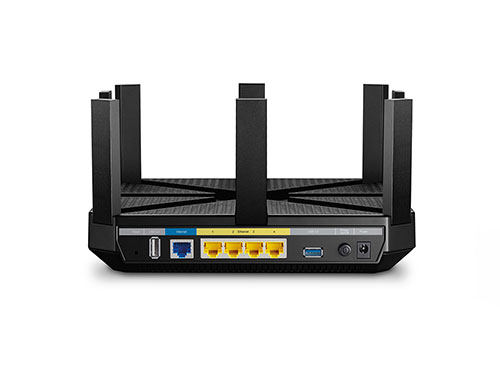|

TP-Link Router offers plentiful features and good rangeBy Jim Bray If your home is plagued by Wi-Fi dropouts and other router issues, you may want to think about an upgrade, perhaps to one that offers multiple bands to up your choices and, with luck, performance. Hence TP-Link's AC5400 Wireless Tri-Band MU-MIMO, also known as the Archer C5400 Gigabit Router. This sucker offers a total of six distinct networks, kind of: 1 x 2.4 GHz, and 2 x 5 GHz, with all three options available for both regular use or as specially noted "Guest" networks, so you won't get in trouble for some overnight interloper's porn downloads. Or whatever your issue may be. Of course, offering a guest network means your visitors can have Wi-Fi without having to know your Wi-Fi password - and in this case you can also choose whether to allow guests to see each other and/or whether to allow them access to your local network (you can let them use the internet but not get at your files). The issue in my house has traditionally been more "coverage" than "capacity" but the Archer C5400 - thanks to the abovementioned pair (or is it four?) of five gig offerings - has that handled, too. Naturally, it depends on where the router is located in your home, but you can't blame the router if you stick it someplace where the sun don't shine - or in some other location where its Wi-Fi signals aren't allowed to roam freely and happily. Time was when you had to live with a single band router, then dual band, so this move to triple bands is a logical development (and quad band routers are available as well). Where will it all end? I've been using a TP-Link router for a while now and have been very happy with its performance (once I figured out that placement issue…). One of the reasons is that it, and this newer model, was designed mostly for home applications where multiple people or devices are slugging it out for bandwidth - whether it's dueling iPads, Rokus, Smart TV's or whatever - and as such they really seem to have a handle on it. To test the router properly, I loaned it to my son, who has also had router complaints traditionally. And even he liked it, though he didn't care a whit for some of the extra features the C5400 offers. He praised its range, though, rating it as excellent - getting Wi-Fi service right to the back of his yard (he was trying to escape responsibility at the time by hiding out). He did mention occasional disconnects with his smart TV, however, though he also admitted it wasn't only the Archer that suffered from this anomaly. It makes me wonder how much of the issues we experienced are because of the router and how much are because of the multitude of devices lapping up the signal. I have no idea, but I do know that some of my devices decide to forget their networking when I shut them down, taking some time to log back in when I fire them up. Again, I have no idea if that's the router or the device, but since other devices don't have this issue I have a feeling the question answers itself. The Archer is quite large physically, looking kind of like a model of a James Bond villain's lair. The eight antennae stick up and make it somewhat hard to place, too, if space is at a premium. The MU-MIMO designation means the router can, according to the company's website, "achieve 4X efficiency by communicating with up to four devices at once." The "Smart Connect" feature means the thing allows each device to access the best band available, automatically, while the abundance of external antennas help to maximize coverage. TP-Link also says the router works with Alexa for voice control and IFTTT for smart home customization, though we didn't try that. We also didn't try its USB disk and printer sharing, Quality of Service (QoS), NAT forwarding with "DMZ" support (for folks living in harm's way on the Korean peninsula?), UPnP, etc., but the features are there if you want them and who can complain about being offered lots of features? Power-user features include VPN Server (OpenVPN or PPTP), Advanced Routing, etc. Setting up the router is very easy. As with the previous one I tried, this one uses a nice, guided wizard-like setup routine. You also can partake of a handy and informative status page in both the Basic and Advanced views in your browser. The Advanced view includes details on all six wireless networks, LAN and WAN settings, USB devices, CPU load, and info on all connected clients (wired and wireless). There's a possible security hole in the setup: it first prompts you to create a new admin user, and if you don't it leaves it at its default, which isn't the most secure idea - though on the other hand it could come in handy if you forget the password! 
Parental control easy to implement if you want to restrict the ankle biters from stuff you don't want them accessing, or merely to limit their access to the internet in general. All you have to do is select a device from the list, then draw a box around "Internet Access Time". The feature seems to be limited to restricting when a device can use the Internet - unless you use it in Advanced mode, in which case it also allows filtering by keyword, though our quick test of this didn't show any evidence of filtering. My son said this could be because so much of the Internet uses SSL encryption now, but all I heard when he explained it to me was gibberish, kind of like when Yondu talked to the Broker in "Guardians of the Galaxy". The fruit of my loins (hey, isn't that anti-LGBTQWERTY or whatever they're calling themselves these days?) also noticed that his Bluetooth performance seemed to be a tad affected once or twice when the device in question was physically near the router - but it doesn't seem to be an issue normally. What could be an issue is the fact that one of the 5G networks seems to have died after less than a week of use at his place. Naturally, I blame him. The rest of the networks have been working fine, though. Not only could my son access his Wi-Fi from the back end of his yard, he also streamed video there smoothly - a distance of over 100 feet. He was impressed enough to note that his usual "medium-end" router craps out at half that distance. A nice touch is the ability to turn on and off the device's LEDs easily (you do it at the top of the admin page in your browser). This could be handy if the router's installed in a location such as a home theatre, where the lights could be annoying. Clearly, TP-Link's Archer AC5400 router does a nice job in and around the connected home. Not only is it a powerful entertainment hub, supporting multiple simultaneous HD video streams, online gaming, music streaming, or whatever, it's just a good router in general (well, there was that one network crapout proving that Murphy's Law has yet to be repealed). Combine that with excellent range and you have a router that, while it demands a premium price of $299 USD, delivers the performance to back it up. Copyright 2017 Jim Bray Jim Bray's columns are available through the TechnoFile Syndicate. We welcome your comments! |
|
|||